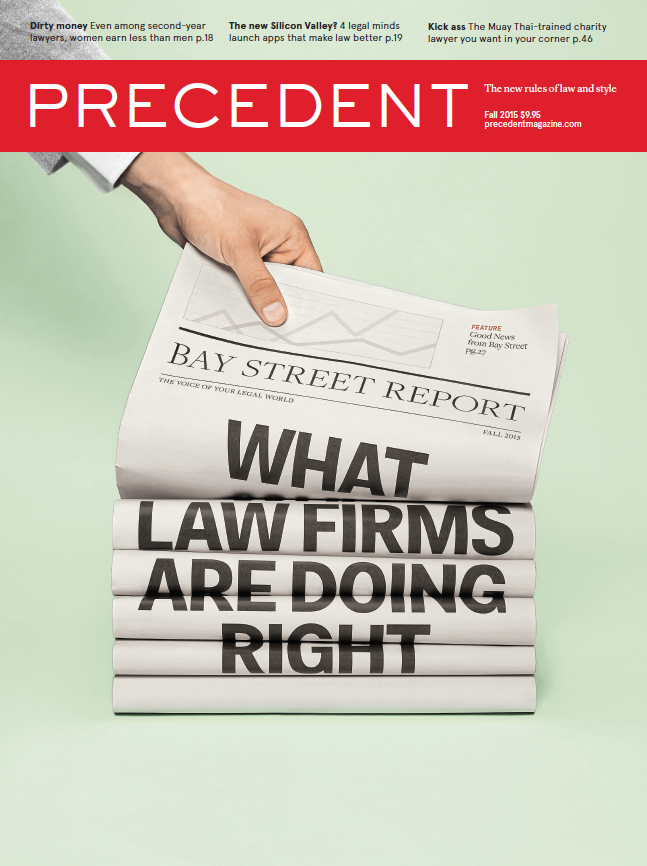In 2008, after working at Torys LLP for seven years, Tom Yeo made partner. At first, nothing changed. “It’s funny, I walked in the next day and got to work on the same files with the same people,” he recalls. “Nothing magical had happened overnight.”
But, over time, things did change — and not for the better. At large Bay Street firms, partners and associates are different in one way: partners must bring in new business. And this slowly became Yeo’s least favourite part of the job.
The pressure to land clients, and the spectre of failing to do so, became constant preoccupations. Sometimes, when at home hanging out with his wife and two young sons, he’d feel guilty that he wasn’t out scrounging up business. “I’d be thinking, Should I be out at a dinner or something?” he recalls. By 2012, Yeo had reached his limit. “I just wasn’t as happy as I thought I should be.”
He asked to meet with Les Viner, the long-time managing partner at Torys, and told him just that. Viner proposed a solution: Yeo could step down as a partner — thus freeing him from his business-development responsibilities — but stay on as a counsel in the corporate group he loved. He quickly accepted. “I’m much happier,” says Yeo, now 43. “I’m delighted with how things worked out.”

“I just wasn’t as happy as I thought I should be.”
Tom Yeo
Counsel at Torys LLP
Had that meeting occurred a few years earlier, the firm might have encouraged Yeo to look for another job. Such a request would have been in line with the so-called “up-or-out” model, an unwritten code that has governed Big Law for much of the past century. It basically consists of one rule: if a senior lawyer (someone with about eight years of experience) is unable to meet the demands of partnership, he or she must leave the firm. But around the time of Yeo’s meeting, Torys had started to break from that tradition.
And Torys is not alone. It’s not yet widespread, but in recent years some of the largest firms on Bay Street are ditching the “up-or-out” model. Another high-profile example is McCarthy Tétrault LLP. Rather than forcing out every lawyer not cut out for partnership, these firms now allow certain top-calibre lawyers, whose work remains profitable for the firm, to stay at the firm in associate or counsel roles.
But why make this change now? With the post-recession legal market still tight, firms are extra picky about who they promote to partner. In the past, all partners brought in some business, but some brought in far more. Today, only top client-getters can make partner, says Jonathan Veale, managing director at the legal-recruitment firm Vision Legal Recruitment. “It’s all about your ability to generate new revenue.”
“The partnership window is narrowing as it gets more competitive,” confirms Robin MacAulay, a director of professional resources at McCarthys. And her counterpart at Torys, Deborah Dalfen, says the number of opportunities is shrinking at her firm, too. “In just the last five years, the world order has changed.”
Neither firm, however, wants to lose lawyers whose work they value. “Offering alternative career paths is about retaining excellent lawyers who may not want to deliver at the same intensity as partners,” says Dalfen. “We want them to know they can stay here and have a long-term career.”
One clear beneficiary of the new paradigm is Kara Smith at McCarthys. Earlier this year, she went from being a fifth-year associate to counsel, explicitly taking her off the partnership track. “In my heart, I knew I didn’t want to be a partner,” says the 32-year-old, unapologetically. “That level of commitment never interested me.”
Had McCarthys remained faithful to the “up-or-out” model, Smith says she likely would have moved in-house, a long-standing haven for private practice lawyers looking for more work-life balance. These days, Smith splits her off-hours between charity work, and leisure with friends and family. And she doesn’t want to give those up. “I want to make sure I can keep doing all the things I love doing outside of law.”
At the same time, the dwindling number of partnership opportunities in Big Law is heartbreaking for one group of lawyers: those who want to make partner, and might have in previous years, but are forced to accept a future as a counsel or long-term associate. “We are not blind to this,” says Dalfen. “In the current senior-associate ranks, this is a real difficulty.”
Still, as both Dalfen and MacAulay see it, the advantages of moving past the “up-or-out” model far outnumber the downsides. (In the United States, by the way, the tradition began to crumble back in the 1980s.) “It’s going very well,” says MacAulay. “We want to have lots of long-term, experienced lawyers working with us, even if they don’t become partners.”
 This story is part our series on how Bay Street firms are getting better, from our Fall 2015 issue.
This story is part our series on how Bay Street firms are getting better, from our Fall 2015 issue.
Concept photography by Chris Thomaidis.


